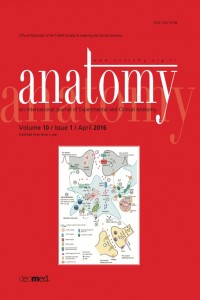Abstract
Objectives: Traube’s space, used to detect spleen enlargement, is at the precordial area on the anterior wall of the chest. In this respect, correct assessment of this area during physical examination is very important. The aim of this study was to evaluate the area of Traube’s space by percussion that is known to be sensitive and specific over 70% and assess effects of gender and defecation habit on the space area.
Methods: Thirty-four males and 32 females participated in the study, examined by the same physician. Traube’s space was determined on the chest wall by percussion. Images of Traube’s space were drawn on a transparent paper using certain reference points for each participant. All images were scanned and measurements were done by AutoCAD 2004 software. Weight and height of the individuals were also measured and their defecation information for the morning they participated in the study was also inquired.
Results: In the males, weight, height, body mass index (BMI) and Traube’s space values were significantly higher than those of females (p<0.05). There was a positive, strong and significant correlation between Traube’s space and weight and height for the whole study group (p<005). There were no statistically significant differences between these two groups when morning defecation was considered (p>0.05).
Conclusion: The results of this study may be useful for the evaluation of Traube’s space and spleen enlargement during physical examination.
References
- Yang JC, Rickman LS, Bosser SK. The clinical diagnosis of
- splenomegaly. West J Med 1991;155:47–52.
- Y›ld›r›m M. Topografik anatomi. ‹stanbul: Nobel T›p Kitabevi;
- p. 283.
- Ökten A. Karn›n fizik muayenesi. In: Kays› A, ed. ‹ç hastal›klar›
- (Semiyoloji). 4. bask›. ‹stanbul: Alfa Yay›nlar›; 2007. p. 426.
- Korkut B, Alt›nbafl A, Sar›güzel A, Özergin U, Gök H. Discrete type
- subaortic stenosis in a patient who had dextrocardia with situs inversus
- totalis. Int J Angiol 1998;7:258–60.
- Ar›nc› K, Elhan A. Anatomi. 2. cilt. 4. bask›, Ankara: Günefl Kitabevi;
- p. 105.
- Barkun AN, Camus M, Meagher T, Green L, Coupal L, De Stempel
- J, Grover SA. Splenic enlargement and Traube’s space: how useful is
- percussion? Am J Med 1989;87:562–6.
- Nixon RK Jr. The detection of splenomegaly by percussion. N Engl
- J Med 1954;250:166–7.
- Castell DO. The spleen percussion sign. A useful diagnostic technique.
- Ann Intern Med 1967;67:1265–7.
- Castell DO, O’Brien KD, Muench H, Chalmers TC. Eastimation of
- liver size by percussion in normal individuals. Ann Intern Med
- ;70:1183–9.
- Sullivan S, Williams R. Reliability of clinical techniques for detecting
- splenic enlargement. Br Med J 1976;2:1043–4.
- Zhang B, Lewis SM. A study of the reliability of clinical palpation of
- the spleen. Clin Lab Haematol 1989;11:7–10.
- Grover SA, Barkun AN, Sackett DL. The rational clinical examination.
- Does this patient have splenomegaly? JAMA 1993;270:2218–21.
Abstract
References
- Yang JC, Rickman LS, Bosser SK. The clinical diagnosis of
- splenomegaly. West J Med 1991;155:47–52.
- Y›ld›r›m M. Topografik anatomi. ‹stanbul: Nobel T›p Kitabevi;
- p. 283.
- Ökten A. Karn›n fizik muayenesi. In: Kays› A, ed. ‹ç hastal›klar›
- (Semiyoloji). 4. bask›. ‹stanbul: Alfa Yay›nlar›; 2007. p. 426.
- Korkut B, Alt›nbafl A, Sar›güzel A, Özergin U, Gök H. Discrete type
- subaortic stenosis in a patient who had dextrocardia with situs inversus
- totalis. Int J Angiol 1998;7:258–60.
- Ar›nc› K, Elhan A. Anatomi. 2. cilt. 4. bask›, Ankara: Günefl Kitabevi;
- p. 105.
- Barkun AN, Camus M, Meagher T, Green L, Coupal L, De Stempel
- J, Grover SA. Splenic enlargement and Traube’s space: how useful is
- percussion? Am J Med 1989;87:562–6.
- Nixon RK Jr. The detection of splenomegaly by percussion. N Engl
- J Med 1954;250:166–7.
- Castell DO. The spleen percussion sign. A useful diagnostic technique.
- Ann Intern Med 1967;67:1265–7.
- Castell DO, O’Brien KD, Muench H, Chalmers TC. Eastimation of
- liver size by percussion in normal individuals. Ann Intern Med
- ;70:1183–9.
- Sullivan S, Williams R. Reliability of clinical techniques for detecting
- splenic enlargement. Br Med J 1976;2:1043–4.
- Zhang B, Lewis SM. A study of the reliability of clinical palpation of
- the spleen. Clin Lab Haematol 1989;11:7–10.
- Grover SA, Barkun AN, Sackett DL. The rational clinical examination.
- Does this patient have splenomegaly? JAMA 1993;270:2218–21.
Details
| Primary Language | English |
|---|---|
| Subjects | Health Care Administration |
| Journal Section | Original Articles |
| Authors | |
| Publication Date | May 1, 2016 |
| Published in Issue | Year 2016 Volume: 10 Issue: 1 |
Cite
Anatomy is the official journal of Turkish Society of Anatomy and Clinical Anatomy (TSACA).


